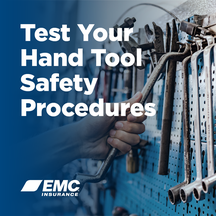- Home
- Loss Control
- Loss Control Insights
- 10 Questions to Test Your Hand Tool Safety Procedures
by Paul Porter, EMC Risk Improvement Senior Engineer
Hand tools get little attention in the safety world, as we focus more on the safe use of power tools. Discussing the safe use of power tools is important because power tool accidents account for 400,000 emergency room visits per year, but hand tools can cause overexertion and injuries to hands and eyes if not used properly.
Hand Tool Hazards
Hand tools are so common in workplaces it’s easy to forget the hazards. Here are some examples of accidents that can occur if hand tools are misused:
- If a screwdriver is used as a chisel, the handle or tip may break and fly off, hitting the user or other employees.
- If a wooden handle on a tool, such as a hammer or an ax, is loose, splintered or cracked, the head of the tool may fly off, striking the user or other employees.
- If the jaw of a wrench is sprung, the wrench might slip, causing a hand injury.
- If struck (hammered) tools (e.g., chisels, wedges or drift pins) have mushroomed heads, the heads might shatter on impact, sending sharp fragments flying toward the user or other employees.
- If a hammer is left on the floor, it could cause a slip, trip or fall.
Test Your Hand Tool Safety Procedures
Answer the following ten questions to see how well you are protecting your employees from potential hand tool accidents:
- Are hand tools that develop mushroomed heads, such as chisels or punches, reconditioned or replaced as necessary?
- Are broken or fractured handles on hammers, axes or similar equipment replaced promptly?
- Are tools secured when an employee is working from height?
- Do employees use appropriate safety glasses, face shields and similar equipment when using hand tools or equipment that might produce flying materials or be subject to breakage?
- Are jacks checked periodically to ensure they are in good operating condition?
- Are tool handles wedged tightly in the heads of all tools?
- Are tool cutting edges kept sharp so that tools will cut smoothly without binding or skipping?
- Do employees use eye and face protection when they strike hardened or tempered tools, bits or nails?
- Are employees trained on how to use the tools and how to select the right tool for the job?
- Do employees put tools back where they belong after use?
Consider the Role Ergonomics Plays in Hand Tool Use
If employees use a tool in a way it was not intended, they might develop injuries such as carpal tunnel syndrome, tendonitis or muscle strain. The best tool fits the job workers are doing, fits the work space available, reduces the force workers need to apply, fits workers’ hands and can be used in a comfortable work position. Often times, the right tool and training is just as important as well-maintained tools.
Want More Hand Tool Safety Information?
Here are a few resources for you to use as you review and enhance your hand tool safety program:
Get in touch
Need help? We’re here for you! Whether you have questions or need personalized assistance, your local office is ready to support you.
Loss Control Insights
Stay informed with the latest news and receive actionable safety tips, all carefully curated by our team of experts.
